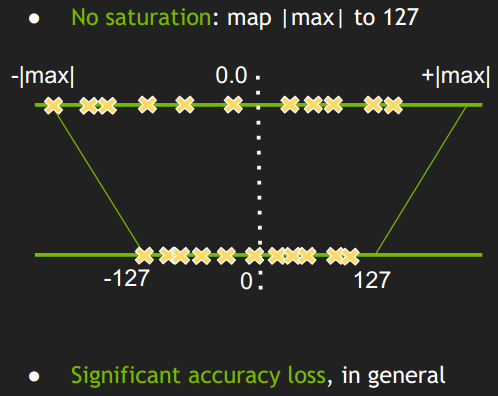MNN学习笔记(1)-----MNN中基于kl_divergence的8bit量化的方法和代码解析
mnn中8bit的量化方法基于两种KL_divergenc 和ADMM 两种方法,本文主要介绍基于kl_divergence的8bit量化方法;
mnn 编译和执行命令
编译:
cd MNN mkdir build cd build cmake -DMNN_BUILD_QUANTOOLS=ON .. make -j4
执行命令:
./quantized.out origin.mnn quan.mnn preprocessConfig.json
配置参数:
{
"format":"RGB",
"mean":[
127.5,
127.5,
127.5
],
"normal":[
0.00784314,
0.00784314,
0.00784314
],
"width":224,
"height":224,
"path":"path/to/images/",
"used_image_num":500,
"feature_quantize_method":"KL",
"weight_quantize_method":"MAX_ABS"
}
默认的量化方法是采用kl_divergenc。
mnn 量化的原理:
借用几张tensor rt的图说明问题,将fp32装换为int8,就是原来使用32bit来表示一个tensor,现在使用8bit来表示一个tensor。最简单的方式就是线性量化:
FP32 Tensor (T) = scale_factor(sf) * 8-bit Tensor(t) + FP32_bias (b)
实验证明,偏置实际上是不需要的,去掉偏置,
T=sf∗t
sf是每一层上每一个tensor 的比例因子(scaling factor)。实际mnn在处理过程中,卷积运算的每一个通道都计算了不同的比例因子。

简单的将一个tensor 中的-|MAX|和|MAX| value 映射为-127和127.中间按照线性关系映射。这种映射关系是不饱和的。这种简单的映射关系,会造成很大的精度损失。mnn和tensorrt的做法是如下:

这种做法不是讲|max|映射为127,而是存在一个阈值|T|,将±|T|映射为±127.,大于±|T|的值直接映射为阈值±127. 目前使用的普遍方法是,使用kl散度取获取kl散度最小的阈值T。
1、什么是kl_divergence
KL(Kullback-Leigler divergence)散度,是用来描述两个概率分布P和Q的差异的一种方法。多应用于概率论和信息论中。在信息论中D(P||Q)表示用概率分布Q来拟合真实分布P时,产生的信息损耗,其中P表示真实分布,Q表示P的拟合分布。
KL散度的定义

python sample 代码:
import numpy as np
def get_distribution(P):
pmax = np.max(P)
distribution=np.zeros(2048)
interval =2048/pmax
for i in P:
index = int(np.fabs(i*interval))
if index >= 2048:
index = 2047
distribution[index]= distribution[index] +1
return distribution
def kl_divergence(P,Q,len):
KL =0.0
for i in range(len):
try:
if Q[i] == 0.0:
KL = KL + 1
else:
KL = KL+ P[i]*np.log(P[i]/Q[i])
except:
print 'Q:{},p:{}'.format(Q[i],P[i])
return KL
def test():
#P = np.random.rand(96*3*11*11)
P = np.random.standard_normal(96*3*11*11)
#Q = np.random.rand(96*3*11*11)
Pdistribution = get_distribution(P)
kl = np.inf
for i in Pdistribution:
if i ==0.0:
print 'zeor'
for k in range(128,2048):
reference_distribution = Pdistribution[:k].copy()
reference_distribution[k-1] = sum(Pdistribution[k::])
interval = k/128.0
#print interval
quantized_distribution = np.zeros(k)
for i in range(128):
start = i*interval
end = (i+1)*interval
leftupper = int(np.ceil(start))
if leftupper > start:
scale = leftupper-start
quantized_distribution[i] += scale * Pdistribution[leftupper-1]
rightlower = int(np.floor(end))
if rightlower < end:
scale = end - rightlower
quantized_distribution[i] += scale * Pdistribution[rightlower]
rightlower = int(np.floor(end))
quantized_distribution[i] = sum(Pdistribution[leftupper:rightlower])
expand_distribution = np.zeros(k)
for i in range(128):
start = i*interval
end = (i+1)*interval
leftupper = int(np.ceil(start))
count = 0
if leftupper > start:
count +=leftupper-start;
rightlower =int(np.floor(end))
if rightlower < end:
count +=end -rightlower
count = count+ rightlower - leftupper
if count ==0:
continue
expandvalue = quantized_distribution[i]/count
if leftupper > start and expand_distribution[leftupper-1] !=0:
expand_distribution[leftupper-1] = expandvalue*(leftupper-start)
if rightlower < end and expand_distribution[rightlower] !=0:
expand_distribution[rightlower] = expandvalue*(rightlower - end)
expand_distribution[leftupper:rightlower] = expandvalue
tempkl = kl_divergence(reference_distribution,expand_distribution,k)
if tempkl < kl:
kl = tempkl
print 'kl :{},index:{}'.format(kl,k)
#print 'kl :{},index:{}'.format(tempkl,k)
#break
return
if __name__=="__main__":
test()
深度学习量化的过程中,真实的分布P,即每一个tensor 都会分为2048个bin。Q用int8 即[0-127]来拟合真实的分布P
MNN中是怎么计算kl_divergence
1、获取Q的真实分布:
从量化模型的命令中可以看到,需要500张图片来模拟真实数据的分布,500张图片前向计算 ,来获取每一层的分布 ,代码入口在Calibration.cpp 文件中,代码如下:
void Calibration::_computeFeatureScaleKL() {
_computeFeatureMapsRange();
_collectFeatureMapsDistribution();
_scales.clear();
for (auto& iter : _featureInfo) {
AUTOTIME;
_scales[iter.first] = iter.second->finishAndCompute();
}
//_featureInfo.clear();//No need now
}
函数_computeFeatureMapsRange 是统计每一个卷积层下每个channel下前向计算的最大值和最小值。_collectFeatureMapsDistribution,是根据获取到每个channel下的最大值来统计2048个bin,每个bin下的权重分布。
finishAndCompute中的_computeThreshold 计算kl散度的最小值,找到最合适的阈值T
int TensorStatistic::_computeThreshold(const std::vector<float>& distribution) {
const int targetBinNums = 128;
int threshold = targetBinNums;
if (mThresholdMethod == THRESHOLD_KL) {
float minKLDivergence = 10000.0f;
float afterThresholdSum = 0.0f;
std::for_each(distribution.begin() + targetBinNums, distribution.end(),
[&](float n) { afterThresholdSum += n; });
for (int i = targetBinNums; i < mBinNumber; ++i) {
std::vector<float> quantizedDistribution(targetBinNums);
std::vector<float> candidateDistribution(i);
std::vector<float> expandedDistribution(i);
std::copy(distribution.begin(), distribution.begin() + i, candidateDistribution.begin());
candidateDistribution[i - 1] += afterThresholdSum;
afterThresholdSum -= distribution[i];
const float binInterval = (float)i / (float)targetBinNums;
// merge i bins to target bins
for (int j = 0; j < targetBinNums; ++j) {
const float start = j * binInterval;
const float end = start + binInterval;
const int leftUpper = static_cast<int>(std::ceil(start));
if (leftUpper > start) {
const float leftScale = leftUpper - start;
quantizedDistribution[j] += leftScale * distribution[leftUpper - 1];
}
const int rightLower = static_cast<int>(std::floor(end));
if (rightLower < end) {
const float rightScale = end - rightLower;
quantizedDistribution[j] += rightScale * distribution[rightLower];
}
std::for_each(distribution.begin() + leftUpper, distribution.begin() + rightLower,
[&](float n) { quantizedDistribution[j] += n; });
}
// expand target bins to i bins
for (int j = 0; j < targetBinNums; ++j) {
const float start = j * binInterval;
const float end = start + binInterval;
float count = 0;
const int leftUpper = static_cast<int>(std::ceil(start));
float leftScale = 0.0f;
if (leftUpper > start) {
leftScale = leftUpper - start;
if (distribution[leftUpper - 1] != 0) {
count += leftScale;
}
}
const int rightLower = static_cast<int>(std::floor(end));
float rightScale = 0.0f;
if (rightLower < end) {
rightScale = end - rightLower;
if (distribution[rightLower] != 0) {
count += rightScale;
}
}
std::for_each(distribution.begin() + leftUpper, distribution.begin() + rightLower, [&](float n) {
if (n != 0) {
count += 1;
}
});
if (count == 0) {
continue;
}
const float toExpandValue = quantizedDistribution[j] / count;
if (leftUpper > start && distribution[leftUpper - 1] != 0) {
expandedDistribution[leftUpper - 1] += toExpandValue * leftScale;
}
if (rightLower < end && distribution[rightLower] != 0) {
expandedDistribution[rightLower] += toExpandValue * rightScale;
}
for (int k = leftUpper; k < rightLower; ++k) {
if (distribution[k] != 0) {
expandedDistribution[k] += toExpandValue;
}
}
}
const float curKL = _klDivergence(candidateDistribution, expandedDistribution);
// std::cout << "=====> KL: " << i << " ==> " << curKL << std::endl;
if (curKL < minKLDivergence) {
minKLDivergence = curKL;
threshold = i;
}
}
} else if (mThresholdMethod == THRESHOLD_MAX) {
threshold = mBinNumber - 1;
} else {
// TODO, support other method
MNN_ASSERT(false);
}
return threshold;
}




 浙公网安备 33010602011771号
浙公网安备 33010602011771号